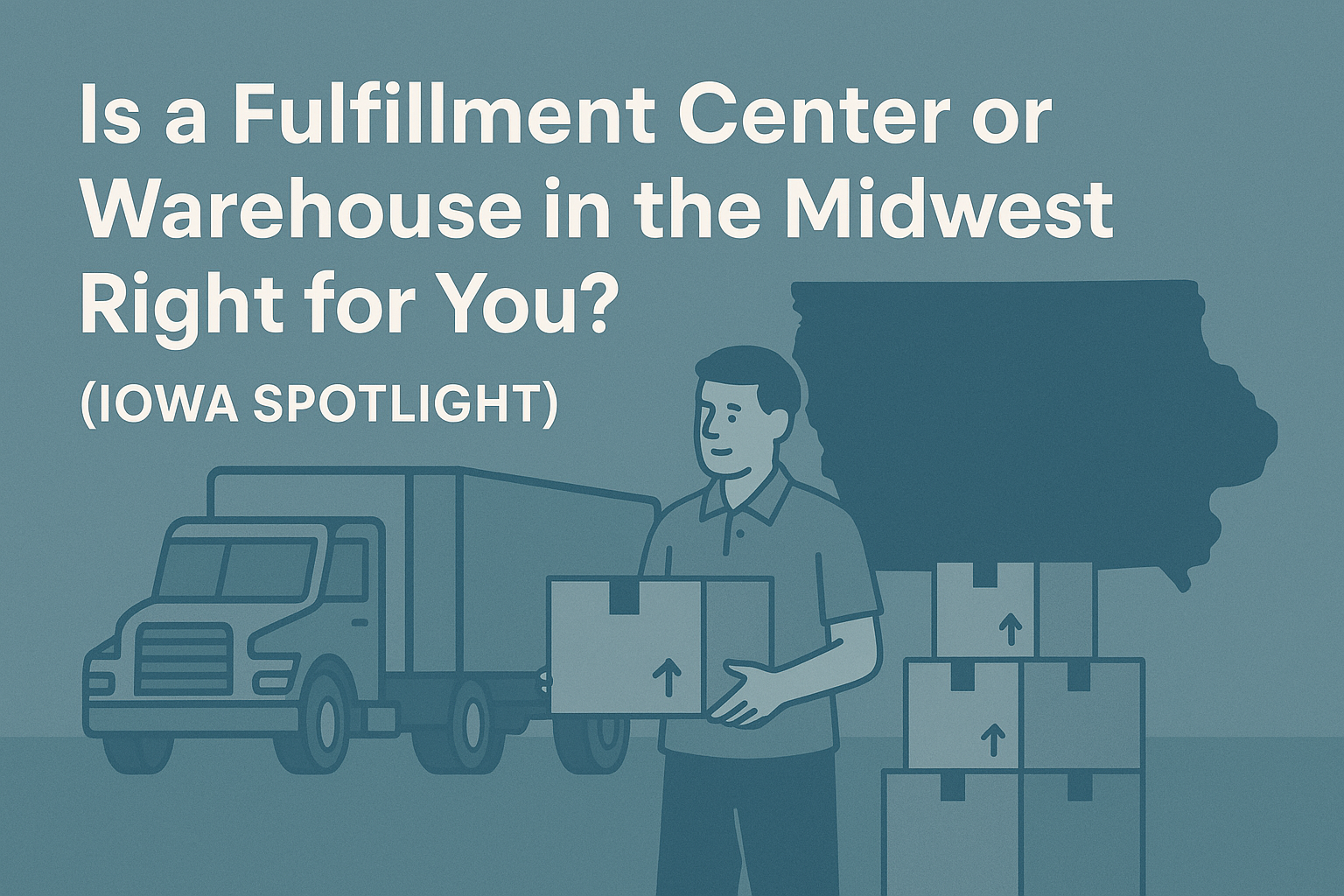Midwest Fulfillment: Is Iowa Your Strategic Advantage? (Location Guide)
In the complex world of e-commerce logistics, choosing the right fulfillment center location is a make-or-break decision. For years, the conversation often centered around the bustling coastal hubs – California for West Coast reach and Asian imports, New Jersey or Virginia for East Coast density and European trade. But as operating costs soar and congestion bites in these prime locations, smart businesses are increasingly looking inland, discovering the powerful strategic advantages of the American Midwest.
Often referred to as America’s Heartland, the Midwest offers a compelling blend of central location, lower operating costs, robust infrastructure, and a stable workforce. It’s a region transforming into a major logistics powerhouse, providing efficient national reach without the coastal price tag. If you’re seeking to optimize your US distribution strategy, reduce shipping times nationwide, and improve your bottom line, overlooking the Midwest could be a costly mistake. This guide explores the benefits of Midwest fulfillment, with a special spotlight on why Iowa, sitting at the region’s crossroads, might be the perfect strategic location for your business.
The Case for the Heartland: Why Look to the Midwest for Fulfillment?
Why shift your focus from the coasts to the center of the country? The Midwest offers several compelling advantages:
Geographic Sweet Spot: Reaching More Customers Faster
The single biggest advantage? Location. The Midwest sits astride the demographic and geographic center of the United States. Locating your fulfillment center here means:
- Minimized Average Distance: You’re closer, on average, to a larger percentage of the US population compared to a single coastal location.
- Nationwide Reach (2-3 Days): Many Midwest locations can reach the vast majority of US consumers via ground shipping within 2-3 business days, meeting modern e-commerce expectations.
- Balanced Coverage: Efficiently serve customers on both coasts, as well as the significant populations in the South and Midwest itself.
Significant Cost Advantages
Operating costs are often substantially lower in the Midwest compared to coastal metropolitan areas:
- Affordable Real Estate: Industrial land and warehouse leasing rates are typically much more competitive.
- Competitive Labor Wages: While variable, average wages for logistics and warehouse staff are generally lower than in high-cost-of-living coastal regions.
- Favorable Tax Environments: Many Midwestern states offer more business-friendly tax structures compared to states like California or New Jersey.
Robust Infrastructure Network
The Midwest isn’t isolated; it’s incredibly well-connected:
- Interstate Highway Hub: Major arteries like I-80, I-90, I-70 (East-West) and I-35, I-55, I-65, I-75 (North-South) crisscross the region, facilitating efficient trucking.
- Strong Rail Networks: Extensive Class I railroad networks provide efficient options for inbound freight and bulk distribution.
- Major Cargo Airports: Hubs like Chicago O’Hare (ORD), Indianapolis (IND), Louisville (SDF – UPS Worldport), and Memphis (MEM – FedEx SuperHub) handle massive air cargo volumes.
Skilled & Stable Workforce
The region boasts a strong tradition of manufacturing and logistics, leading to:
- Experienced Labor Pool: Access to workers familiar with warehousing, distribution, and transportation.
- Strong Work Ethic: Often cited for reliability and lower turnover rates compared to some hyper-competitive markets.
- Logistics Training Programs: Increasing investment in community college and technical programs focused on supply chain and logistics skills.
Spotlight on Iowa: A Prime Midwest Fulfillment Location
Within the advantageous Midwest region, Iowa stands out as a particularly compelling option for fulfillment operations. It combines the general benefits of the Midwest with its own unique strengths:
Iowa’s Strategic Position: The Crossroads Advantage
Iowa sits uniquely at the intersection of two of the nation’s most critical interstate highways:
- I-80: The primary East-West corridor spanning coast-to-coast.
- I-35: The major North-South corridor connecting Canada to Mexico.
This “crossroads” location provides exceptional one-day trucking access to major metropolitan areas like Chicago, Minneapolis, St. Louis, Kansas City, Omaha, and Des Moines, and efficient two-day reach to Denver, Dallas, Indianapolis, and beyond.
Transportation Infrastructure in Iowa
Beyond the major interstates, Iowa offers:
- Well-Maintained Highway System: Efficient movement of goods within the state and connecting to the national network.
- Significant Rail Access: Served by major Class I railroads, offering competitive options for freight movement.
- Regional Air Cargo: Des Moines International Airport (DSM) and other regional airports provide air freight capabilities.
Compelling Cost Structure
Iowa consistently ranks favorably for its cost of doing business:
- Highly Competitive Real Estate: Industrial land and building costs are significantly lower than national averages and coastal hubs.
- Affordable Labor Market: Offers competitive wages and a lower overall cost of living compared to major coastal states, contributing to labor cost savings.
- Business-Friendly Tax Climate: Iowa has made strides in tax reform, aiming for a competitive corporate tax environment. (Confirm specific benefits via sources like the Iowa Economic Development Authority).
Workforce & Business Climate
- Educated and Productive Workforce: Known for high education levels and a strong work ethic.
- State Support: Actively promotes business growth with various development programs and incentives.
- Lower Congestion Risk: While growing, Iowa’s logistics hubs generally experience far less traffic and port congestion compared to Tier 1 coastal markets like LA/Long Beach or NY/NJ.
These factors make Iowa a strong contender for businesses seeking efficiency and value. Leveraging dedicated Iowa fulfillment warehouse services can unlock these strategic benefits.
Midwest (Iowa) vs. Coastal Fulfillment: A Comparative Look
How does a Midwest location like Iowa stack up against traditional coastal hubs?
| Feature | Midwest (Spotlight: Iowa) | Coastal Hubs (e.g., CA / NJ) |
|---|---|---|
| National Reach/Speed | Excellent (2-3 days typical); Balanced coverage nationwide. | Fastest to immediate coast (1-2 days); Slower/Costlier cross-country. |
| Operating Costs (Warehouse) | Significantly Lower (Real estate, utilities, taxes). | Significantly Higher. |
| Labor Costs | Lower / More Competitive Wages. | Higher Wages / High Competition. |
| Infrastructure Density | Robust Interstate/Rail network. | Hyper-Dense Network around major metros. |
| Congestion Levels | Generally Lower (Traffic & Port). | Higher Risk (Traffic & Port). |
| Proximity to Int’l Ports | Requires longer inbound freight from coastal ports. | Direct access (but potentially congested). |
Who Thrives with Midwest/Iowa Fulfillment? Use Case Scenarios
Certain business models are particularly well-suited for a Midwest strategy:
Scenario 1: The National E-commerce Retailer Selling Diverse Goods
- Challenge: A brand selling nationwide finds that fulfilling from their single California warehouse results in 5+ day shipping times and high costs for East Coast customers.
- Midwest/Iowa Solution: Moving to or adding an Iowa fulfillment center drastically cuts average transit time to 2-3 days nationally and significantly lowers overall shipping expenses due to better zone optimization.
Scenario 2: The Cost-Sensitive Brand Competing on Price
- Challenge: A company selling lower-margin goods finds the high rent and labor costs of their New Jersey fulfillment center unsustainable.
- Midwest/Iowa Solution: Relocating fulfillment operations to Iowa provides immediate relief on operating costs (rent, labor, taxes), allowing them to maintain competitive pricing while still offering acceptable 2-4 day shipping nationwide.
Scenario 3: Business with Strong Midwest Supplier/Manufacturing Base
- Challenge: A company sources many components or finished goods from agricultural producers or manufacturers located throughout the Midwest.
- Midwest/Iowa Solution: Locating their fulfillment center in Iowa reduces inbound transportation costs and lead times from their suppliers, streamlining their supply chain from source to customer.
Key Considerations Before Choosing the Midwest (or Iowa)
While compelling, a Midwest location isn’t universally perfect. Consider:
- Customer Geography: Is your customer base truly national, or heavily skewed to one coast? If heavily coastal, the speed advantage of a coastal hub might outweigh Midwest cost savings.
- Inbound Freight Costs: If 100% of your goods arrive via ocean freight to a single coast, factor in the potentially higher cost of trucking or railing goods inland to your Midwest fulfillment center.
- Carrier Service Levels: Confirm pickup times and service level guarantees (e.g., Ground, Express) offered by major carriers (UPS, FedEx, USPS) in the specific Iowa location you’re considering.
- Specialized Needs: Do your products require specific infrastructure less common in the region (e.g., extensive cold storage, specialized handling equipment)?
- State/Local Incentives: Research potential economic development incentives offered by the state or specific municipalities in Iowa for setting up logistics operations.
Key Takeaways: Why the Midwest (and Iowa) Deserves Your Attention
For businesses looking to optimize US distribution:
- Centrality is Key: Reach more customers faster nationwide.
- Cost Savings are Real: Lower real estate and labor costs boost profitability.
- Infrastructure is Strong: Well-connected via highway, rail, and air.
- Iowa Offers Specific Advantages: Prime crossroads location, favorable costs, supportive business climate.
- It’s a Strategic Alternative: Don’t default to coastal hubs without evaluating the Heartland.
Conclusion: Look Inland for Your Fulfillment Advantage
The quest for the optimal U.S. fulfillment location requires looking beyond the traditional coastal strongholds. The American Midwest, with its strategic central positioning, significant cost advantages, and robust infrastructure, presents a powerful alternative for businesses aiming for efficient, cost-effective national distribution. Within this promising region, Iowa shines brightly, offering a unique crossroads advantage, a business-friendly environment, and competitive operating costs.
By carefully analyzing your customer distribution, inbound logistics, cost sensitivity, and service level needs, you might discover that a Midwest location, particularly Iowa, offers the ideal balance to propel your e-commerce growth. Don’t let outdated assumptions guide your logistics strategy – explore the potential of the Heartland.
Interested in leveraging the strategic advantages of a Midwest hub? Discover how our dedicated Iowa fulfillment warehouse services can optimize your distribution network and lower your costs.
Frequently Asked Questions (FAQ) about Midwest & Iowa Fulfillment
Q1: Realistically, how fast can I ship to most of the US population from Iowa?
A: From strategic locations in Iowa, leveraging major carriers’ ground networks, it’s realistic to reach a significant majority (often estimated at 80%+) of the continental US population within 2-3 business days. Major metropolitan areas within roughly 500-700 miles (like Chicago, Minneapolis, Kansas City, St. Louis) can often be reached in 1 business day.
Q2: Are warehouse labor costs significantly lower in Iowa compared to coastal states like California or New Jersey?
A: Yes, generally. While wages vary within the state, average warehouse and logistics labor costs in Iowa are typically substantially lower than in high-cost-of-living coastal metropolitan areas. This is driven by lower housing costs, state minimum wage differences, and differing labor market dynamics (e.g., union density). This can translate into significant savings on fulfillment labor expenses.
Q3: What are the key transportation routes that make Iowa strategic for logistics?
A: Iowa’s primary strategic advantage comes from the intersection of two major national corridors:
- Interstate 80 (I-80): A critical East-West route connecting New York City to San Francisco.
- Interstate 35 (I-35): A major North-South route connecting Duluth, Minnesota near the Canadian border down to Laredo, Texas on the Mexican border.
Access to these interstates allows for efficient trucking distribution across the entire country.
Q4: Is Iowa a good fulfillment location if most of my products are imported via coastal ports?
A: It can be, but requires careful analysis. While Iowa offers excellent *outbound* distribution, you must factor in the cost and time of transporting your imported goods *inbound* from the coastal port (e.g., LA/Long Beach, NY/NJ) to Iowa via truck or rail. If the savings on outbound shipping and operating costs outweigh the added inbound freight expense, then Iowa can still be highly advantageous. This is often the case for businesses with a truly national customer base.
Q5: What types of industries are strong in Iowa that might particularly benefit from local fulfillment?
A: Iowa has strong roots in agriculture and advanced manufacturing. Businesses involved in:
- Agricultural technology (AgTech) and equipment.
- Food processing and distribution (requiring potential cold storage).
- Advanced manufacturing components and finished goods.
- Renewable energy sector components.
- Biosciences.
These industries might find significant benefits in reduced inbound logistics costs and proximity to suppliers by utilizing Iowa-based fulfillment centers.

